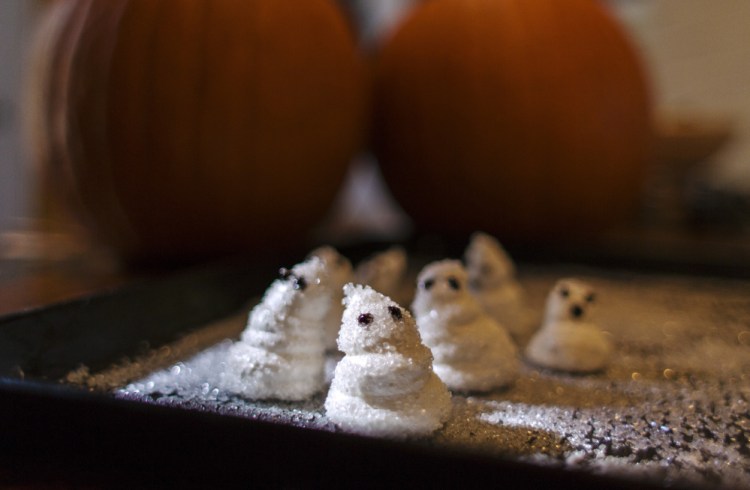My Peep-loving husband was incredulous about my attempts to replicate his favorite candy using the viscous water that comes in a can of chickpeas. “Why would anyone want do that,” he asked, muttering something about mucking with perfection.
Waste not, want not. That’s why. I’d already sprung for the can of cooked chickpeas because I’d forgotten to soak the bulk-bin dried garbanzo beans the night before and I wanted to make hummus. I was attempting to salvage my daily green-eating quotient by figuring out how to use the aquafaba.
This magical “bean water” has whipped up excitement throughout the vegan community as it can replace eggs whites in everything from mayonnaise to mousse. The chemistry of aquafaba is still considered uncharted territory, but basically it mimics egg whites in that when mixed at high speeds, proteins get suspended in liquid to form first a froth, and then a stable, stiff-peaked foam.
Most legumes will leave these proteins behind in the water in which they sit, but chickpea water produces the foam that most resembles snowy whipped egg whites.
An Indiana vegan blogger named Goose Wholt coined the term in 2015 after using chickpea water to make eggless macaroons for his family’s Passover Seder. He’d gotten the idea from two French vegans who posted an online video on making a rich chocolate dessert with whipped chickpea water and vegan chocolate ganache.
For the home cook, experts in the Vermont-based King Arthur Flour test kitchen say aquafaba is best used as an egg-white replacement in baked goods where you are drying sugars (say a meringue) as opposed to setting proteins (as in flourless chocolate cake). Chef Joanne Chang, owner of Flour bakeries in Boston, says her team regularly uses aquafaba to make its vegan mayonnaise and salad dressings. Her team has also tested it in meringues but has had only limited success making the large batches required for her business.
Melissa Maidana, a vegan personal chef based in Arundel, had a few tips for the vegan meringue-baking home cook: Bake the meringues on a Silpat, allow them to sit for 2 to 3 hours before baking and always refrigerate them after baking and cooling or they may be too firm.
Since my can of chickpeas gave up only two-thirds of a cup of aquafaba, I didn’t have to worry about volume production. I’ve got plenty of egg white cubes in my freezer should I want to make meringues. But what I don’t keep in the house – because it’s a highly processed food, full of corn syrup and sugar as well as dried egg whites – is Marshmallow Fluff. I miss it dearly stirred into Rice Krispy treats, slathered into a fluffernutter sandwich on white bread or floating on top of my hot chocolate.
Aquafaba has emerged as the vehicle for my controlled fluff fix. From one can of beans, ½ cup of organic sugar and a bit of xanthan gum (it gives the bean marshmallow the right spring), I can make two cups of fluff (see recipe).
And since I know what you’re thinking, no, the confection, surprisingly, does not taste at all like beans. In my testing, though, I found it best to buy low-sodium beans so that the final result isn’t too salty.

Once all the ingredients are whipped, the marshmallow will become extremely thick and gummy. Ben McCanna/Staff Photographer
The internet tells me I could use the water from cooked, dried chickpeas to make aquafaba-based sweets. But I had no luck making that happen. Even when I cooked the chickpeas in the water in which I had soaked them, the aquafaba frothed but did not form stiff peaks. My homemade aquafaba is more efficiently used in soup than confections. I’ll make this concoction only after I open a can of chickpeas – that way I’ll keep my energy use (you have to whip aquafaba in a stand mixer for as long as five minutes) and the fluff habit in check.
My husband was biased from the start, so he refused to accept either the faux fluff or my posing Peeps as a satisfactory substitute for what he considers the genuine article. In fact, the only part of this project he liked was the chickpea curry I made from the three cans and two batches of garbanzos I cooked during my little aquafaba testing project.
My daughter, though, said it was better than commercial fluff because it was neither as sticky nor as sweet. When I told her the ingredients, she just said “Ewww!”
All the more for me.
Christine Burns Rudalevige is a food writer, a recipe developer and tester, and a cooking teacher in Brunswick. Contact her at: cburn1227@gmail.com.
Send questions/comments to the editors.


